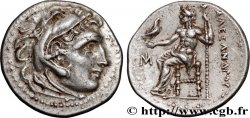bga_655571 - RAURACI - RAURAQUES Bronze, imitation de denier romain de Plaetoria
недоступный.
Товар уже продан в нашем интернет-магазине (2022)
Цена: : 140.00 €
Товар уже продан в нашем интернет-магазине (2022)
Цена: : 140.00 €
Тип Bronze, imitation de denier romain de Plaetoria
Дата: après 67 AC.
Металл: bronze
Диаметр: 17 mm
Ориентация осей монеты: 11 h.
Вес: 2,25 g.
Редкость: R3
Комментарии о состоянии
Bronze sur un flan un peu court, mais avec les types complets. Patine brune et régulière
Ссылки в каталоге: :
Лицевая сторона
Аверс: легенда: CESTIANVS/ S.C.
Аверс: описание: Buste ailé, casqué, lauré, couronné d'épis et drapé de Vacuna à droite avec une corne d'abondance ; le tout entouré de la stemma, “corona infula”.
Аверс: перевод: “Cestianus/ Senatus Consulto”, (Cestianus/ avec l’accord du Sénat).
Обратная сторона
Реверс: легенда: M. PLAETORIVS. M. F. AED - CVR.
Реверс: Описание: Aigle debout à droite sur un foudre, détournant la tête à gauche ; le tout entouré de la stemma “corona infula”, (bandelette de laine).
Реверс: перевод: “Marcus Plætorius Marci Filius Ædilis Curilis”, (Marcus Plætorius fils de Marc Édile curule).
Комментарий
Pour ce type de denier, M. Crawford a relevé une estimation de 58 coins de droit et de 64 coins de revers. Ce denier aurait inspiré, pour le droit, les petites monnaies en bronze et en argent EPAD, données aux Arvernes (LT. 3900).
Ce type de bronze en serait une copie servile, mais frappé en bronze au lieu de l’argent, par les Rauraques (?).
For this type of denarius, Mr. Crawford noted an estimate of 58 obverse dies and 64 reverse dies. This denarius would have inspired, for the obverse, the small bronze and silver EPAD coins, given to the Arverni (LT. 3900). This type of bronze would be a servile copy, but struck in bronze instead of silver, by the Rauraci (?)
Ce type de bronze en serait une copie servile, mais frappé en bronze au lieu de l’argent, par les Rauraques (?).
For this type of denarius, Mr. Crawford noted an estimate of 58 obverse dies and 64 reverse dies. This denarius would have inspired, for the obverse, the small bronze and silver EPAD coins, given to the Arverni (LT. 3900). This type of bronze would be a servile copy, but struck in bronze instead of silver, by the Rauraci (?)








 Cообщить об ошибке
Cообщить об ошибке Распечатать страницу
Распечатать страницу Отправить мой выбор
Отправить мой выбор Задать вопрос
Задать вопрос Consign / sell
Consign / sell
 Информация
Информация






